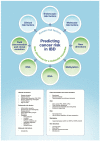Predicting Colorectal Cancer Occurrence in IBD
- PMID: 34200768
- PMCID: PMC8230430
- DOI: 10.3390/cancers13122908
Predicting Colorectal Cancer Occurrence in IBD
Abstract
Patients with colonic inflammatory bowel disease (IBD) are at an increased risk of developing colorectal cancer (CRC), and are therefore enrolled into a surveillance programme aimed at detecting dysplasia or early cancer. Current surveillance programmes are guided by clinical, endoscopic or histological predictors of colitis-associated CRC (CA-CRC). We have seen great progress in our understanding of these predictors of disease progression, and advances in endoscopic technique and management, along with improved medical care, has been mirrored by the falling incidence of CA-CRC over the last 50 years. However, more could be done to improve our molecular understanding of CA-CRC progression and enable better risk stratification for patients with IBD. This review summarises the known risk factors associated with CA-CRC and explores the molecular landscape that has the potential to complement and optimise the existing IBD surveillance programme.
Keywords: cancer risk; inflammatory bowel disease; molecular biomarkers; molecular risk factors; risk factors.
Conflict of interest statement
The authors declare no conflict of interest.
Figures
Similar articles
-
Colorectal cancer in inflammatory bowel disease: what is the real magnitude of the risk?World J Gastroenterol. 2012 Aug 7;18(29):3839-48. doi: 10.3748/wjg.v18.i29.3839. World J Gastroenterol. 2012. PMID: 22876036 Free PMC article. Review.
-
Colorectal Cancer in Inflammatory Bowel Disease: Epidemiology, Pathogenesis and Surveillance.Gastrointest Tumors. 2014 Aug;1(3):146-54. doi: 10.1159/000365309. Epub 2014 Jul 18. Gastrointest Tumors. 2014. PMID: 26674110 Free PMC article. Review.
-
Colitis-Associated Colorectal Cancer in Patients with Inflammatory Bowel Diseases in a Tertiary Referral Center: A Propensity Score Matching Analysis.J Clin Med. 2022 Feb 7;11(3):866. doi: 10.3390/jcm11030866. J Clin Med. 2022. PMID: 35160321 Free PMC article.
-
Root-cause analyses of missed opportunities for the diagnosis of colorectal cancer in patients with inflammatory bowel disease.Aliment Pharmacol Ther. 2021 Jan;53(2):291-301. doi: 10.1111/apt.16155. Epub 2020 Nov 7. Aliment Pharmacol Ther. 2021. PMID: 33159472 Free PMC article.
-
Current management of inflammatory bowel disease and colorectal cancer.Gastrointest Cancer Res. 2011 Mar;4(2):53-61. Gastrointest Cancer Res. 2011. PMID: 21673876 Free PMC article.
Cited by
-
A mendelian randomization study with populations of European ancestry rules out a causal relationship between inflammatory bowel disease and colorectal cancer.Front Genet. 2022 Aug 24;13:949325. doi: 10.3389/fgene.2022.949325. eCollection 2022. Front Genet. 2022. PMID: 36092900 Free PMC article.
-
The Oxidative Stress and Nervous Distress Connection in Gastrointestinal Disorders.Biomolecules. 2023 Oct 27;13(11):1586. doi: 10.3390/biom13111586. Biomolecules. 2023. PMID: 38002268 Free PMC article. Review.
-
Prognostic and tumor immunity implication of inflammatory bowel disease-associated genes in colorectal cancer.Eur J Med Res. 2022 Jun 13;27(1):91. doi: 10.1186/s40001-022-00720-0. Eur J Med Res. 2022. PMID: 35698180 Free PMC article.
-
Caspase-4 Has Potential Utility as a Colorectal Tissue Biomarker for Dysplasia and Early-Stage Cancer.Gastro Hep Adv. 2024 Sep 16;4(2):100552. doi: 10.1016/j.gastha.2024.09.007. eCollection 2025. Gastro Hep Adv. 2024. PMID: 39866724 Free PMC article.
-
A Review on the Immunomodulatory Mechanism of Acupuncture in the Treatment of Inflammatory Bowel Disease.Evid Based Complement Alternat Med. 2022 Jan 15;2022:8528938. doi: 10.1155/2022/8528938. eCollection 2022. Evid Based Complement Alternat Med. 2022. PMID: 35075366 Free PMC article. Review.
References
-
- Listrom C., Holt K. Inflammatory bowel disease. Emerg. Med. 2004;36:24–28.
-
- Alatab S., Sepanlou S.G., Ikuta K., Vahedi H., Bisignano C., Safiri S., Sadeghi A., Nixon M.R., Abdoli A., Abolhassani H., et al. The global, regional, and national burden of inflammatory bowel disease in 195 countries and territories, 1990–2017: A systematic analysis for the Global Burden of Disease Study. Lancet Gastroenterol. Hepatol. 2017;5:17–30. doi: 10.1016/S2468-1253(19)30333-4. - DOI - PMC - PubMed
-
- Ng S.C., Shi H.Y., Hamidi N., Underwood F.E., Tang W., Benchimol E.I., Panaccione R., Ghosh S., Wu J.C.Y., Chan F.K.L., et al. Worldwide incidence and prevalence of inflammatory bowel disease in the 21st century: A systematic review of population-based studies. Lancet. 2018;390:2769–2778. doi: 10.1016/S0140-6736(17)32448-0. - DOI - PubMed
-
- National Institute for Health and Clinical Excellence, Centre For Clinical Practice Scope, Ulcerative Colitis: The Management of Ulcerative Colitis. [(accessed on 12 May 2021)];2011 :1–10. Available online: https://www.nice.org.uk/guidance/cg166/documents/ulcerative-colitis-fina....
Publication types
Grants and funding
LinkOut - more resources
Full Text Sources


